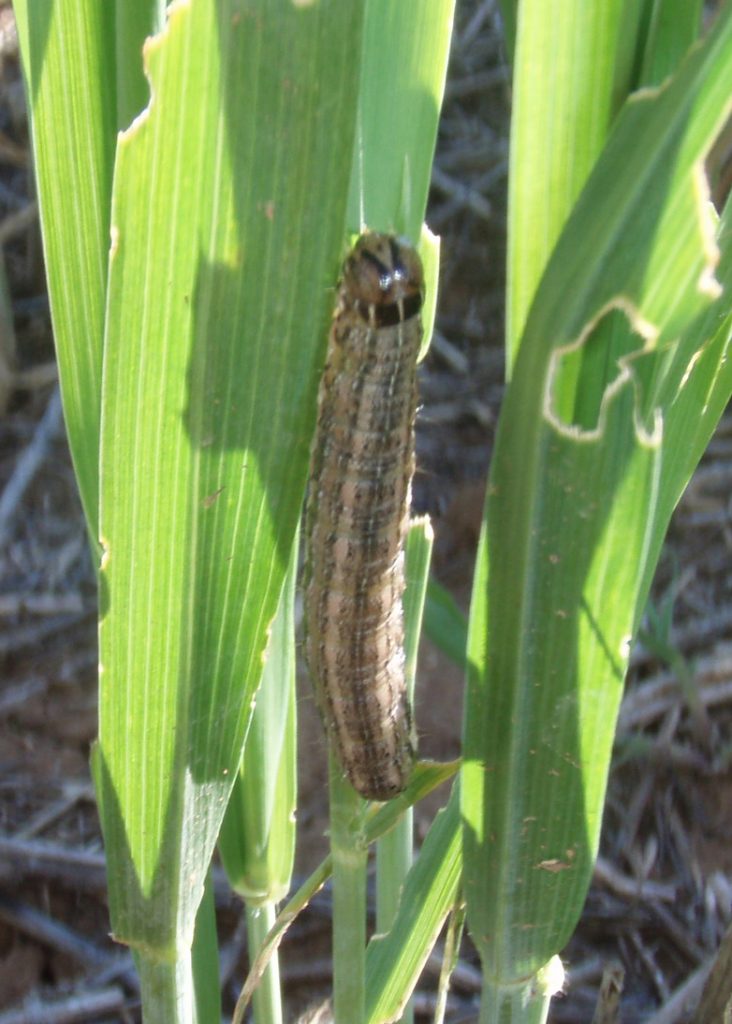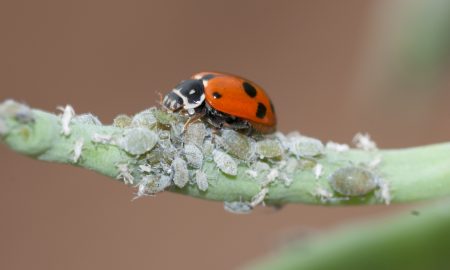Various species of caterpillar pests appear to be ‘enjoying’ the conditions of this season. Although little is known about several of the species, being able to distinguish the pest (and its feeding damage) is a critical first step in successful management.
Where have they been reported?
‘Caterpillars in crops’ has been a strong theme in recent reports from western Victorian, but they are represented by a variety of species with quite different markings (on close inspection!) and plant preferences.
Caterpillars (8-30 mm in length) with subtle herringbone markings along their backs have been causing plant damage in lentil and pea crops in the Beulah area of the Mallee. Damage included lopping off branches or whole plants.
‘Cutworm-like caterpillars’ with similar markings have also been damaging lucerne in the Ouyen area of the Mallee.
In the central Mallee, caterpillars with herringbone markings have been recorded feeding on cereal flag leaves.
Further south, near Donald in the Wimmera, caterpillars with similar markings have been found nibbling on the lower leaves of faba beans and lentils.
It is likely that these caterpillars belong to several species, probably from within the Proteuxoa genus, representing both climbing and ground-active caterpillars.
True armyworms (Leucania spp.), or the damage that they typically cause, have been observed in a number of Mallee cereal crops such as those near Charlton, Minyip, Boort, Quambatook, Berriwillock and in the northern Wimmera.
In the Charlton crop, armyworms (about 10-20 mm in length) have been causing moderate to severe foliar damage and also removing the occasional secondary tiller. Moderate damage is typically seen as leaf scalloping along the length of cereal flag and secondary leaves. In most cases, the damage is tolerable at this stage.
Armyworms have also been observed in grass weeds within a faba bean crop near Donald in the Wimmera.

Distinguishing common caterpillars in vegetative crops
As with most pests, wise decisions on the need for control and appropriate management tactics for caterpillars depends on correct identification.
It is disappointing, but most taxonomic work done on caterpillar species is on the basis of the adult stage (moths), not larvae. There are various reasons for this, but larvae (caterpillars) can vary greatly in their appearance.
We provide the following guides for caterpillars, but there will be exceptions! This guide applies to caterpillars that have four sets of abdominal prolegs (see first diagram in this PestNote), in contrast to loopers (such as brown pasture looper that have 1 or 2 sets).
Smooth bodied caterpillars with three different distinct and coloured stripes running the length of the body. Three light stripes on the collar behind the head.
Armyworms (Leucania spp. and Persectania spp.)
These feed exclusively on grasses and cereals and will not damage other crops. They tend to be foliage feeders and in late season barley, larger caterpillars will sever maturing heads. They will not lop seedlings.
Early signs suggest that armyworms could be common this year, although it is too early to say if they will be a serious crop threat (see “Our advice” below).
Caterpillars with a uniform dull colour without clear stripes or markings (indistinct banding may be present)
These are ground dwelling caterpillars that commonly nip off emerging seedlings or early leaves.
They will attack all seedling crops and pastures. They are not commonly found feeding in the canopy.
They were a major pest during crop establishment in 2014 but have been all but absent this season.
Caterpillars with various ‘herringbone’ patterns along their body, made up of a lighter coloured diagonal marking on several abdominal segments.
Unfortunately, there is (as yet) no common name for this group. These caterpillars mostly appear to belong to the Proteuxoa genus and can be quite varied in form and plant host.
Different species have been found attacking both cereal/grasses (Graminae) and broadleaf crops (pulses and oilseeds), although it is unlikely that any one species would cross over between groups, say from cereals to pulses. Reports over the years suggest that most species prefer cereals and grasses, but certainly not all.
This group is often found in the crop canopy and have been commonly reported this season.

(For the sake of completeness) Caterpillars with distinct stripes and prominent hairs
Native budworm (Helicoverpa punctigera) and pasture day moth (Apina callisto).
Our advice
Ensure correct identification of caterpillars before deciding on the most appropriate management action required.
It is unusual for armyworms to be active at this time of year, indicating egg-laying from early winter.
From now on, armyworm feeding in cereals will become reasonably voracious, but in most cases the damage is unlikely to warrant control.
In addition, according to our prediction model, this generation is very likely to cease feeding and pupate by mid September, well before most barley crops are susceptible to cereal head lopping.
This does not preclude the possibility of continuous egg-laying going in to spring; monitoring cereal crops with a sweep net is recommended.
The use of insecticides in winter to control armyworms will also risk eliminating the beneficials that, in many cases, moderate aphid and caterpillar populations. The loss of beneficials can often induce earlier or secondary pest outbreaks.
Acknowledgements
Sources of field reports of caterpillars
Ben Brown – Agronomist, JSA Independent (Victorian Wimmera)
Simon Craig – Agronomist, BCG (Victorian Mallee)
Erin Johns – Agronomist, JSA Independent (Victorian Wimmera)
Craig Muir – Agronomy Consultant, AGRIVision (Victorian Mallee)
Ash Wallace – Regional Research Agronomist, DEDTJR (Victorian Wimmera)
Matthew Whitney – Agronomist, Dodgshun Medlin (Victorian Mallee)
Kate Wilson – Consultant, AGRIVision Consultants (Victorian Mallee)
Cover image: Photo by Cesar Australia





